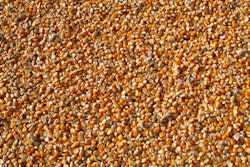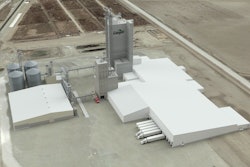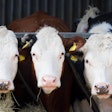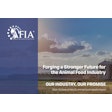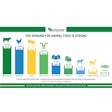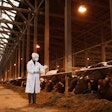
How aiming for waste-free protein can boost sustainability (15:34)
Ann Reus: Hello and welcome to the Feed Strategy podcast. I'm your host, Feed Strategy senior reporter Ann Reus.
Today I'm joined by the president of ADM Animal Nutrition, Ismael Roig. He's here to talk about how feed additives can improve animal performance, advances in sustainability, consumer trends influencing animal nutrition and more.
Hi, Ismael. Thank you for being here with me today.
Ismael Roig: My pleasure, Ann.
Reus: Nutrition is obviously important to supporting animal health and productivity. In what ways do certain feed additives and ingredients optimize animal performance?
Roig: Well, feed additives and ingredients are a very comprehensive list of ingredients. They play a role in many facets of the animal life cycle. So, some of them actually act directly on the ability for an animal to nutritionally uptake the feed. In others, the additives play a role in protecting gut health. So they either have antimicrobial effects or antibacterial effects. Others can act in in in other ways, for example, they can protect the skin of an animal, or they can protect them vis-à-vis diseases or heat stress, for example, so they have a very broad range of application, and they are essential in the overall nutritional makeup of any animal, frankly, no different than it is for us. We all need to take our basic proteins, fats and carbohydrates but if we want for minerals, and vitamins, and other additives of that nature, we would not be able to sustain our health.
Historically, the focus on feed efficiency has been primarily around the formulation of the feed itself, of which additives is something that we that we talked about. Some of the advances that we've seen are not just about the nutrition in and of itself, but also the overall life cycle management of the animals. So when you're looking at a feed conversion efficiency, you need to look at not only the genetic quality of the animal. So, we've seen a lot of advances in the genetics of animals. You also need to look at early infant mortality; it isn't just about an animal that lives a full life but doesn't do a very good job at making full use of the nutrition that you provided, it's also about mortality. So we're still experiencing quite a heavy toll on early stage mortalities, addressing the mortality of things like chicks and piglets as an example. And then it's also how you maintain the animal over its full lifetime. So what you're seeing is a lot of technology being applied around creating the best environment for the animal to be in, for example, avoiding heat stress for the animal. You're even seeing advances like adapting the way in which you milk a cow to its particular behavior. I mean, some cows can be, you can actually address milking in the morning, in the afternoon in the evening; other cows are more comfortable doing it at a different times. So there's technology now that allows for that flexibility, and actually has had an interesting effect on overall efficiency, 10-15% improvements. So I think the evolution is partly around nutrition, for sure. But I think the more significant improvements are now happening around the technology from the genetics all the way through the animal upkeep through its life cycle. And that's a very interesting area of development.
Reus: How does ADM work to enhance sustainability in its business and for its customers?
Roig: When you look at the overall waste profile of animals, there are a number of categories that are important. The first category is obviously feed conversion. So if you take, for example, the average feed conversion in a developed country like Holland, for example, it is probably two times, at times three times the feed conversion that you're able to achieve in China. If we were able to get swine and poultry production in China at the same feed conversion ratios that we have in key countries in Western Europe, we would probably save about 40 million tons of grains. Actually, if you look at that number on a worldwide basis, we could probably save more than 100 million tons, which is about being able to feed another billion people. So one of our key areas of focus is to create a waste-free source of protein. I mean, how do we move towards an aspirational goal of making the animal conversion process a waste-free source of protein. And by waste free doesn't mean zeroing it out. It means achieving the highest level of efficiency as possible. And I think the numbers that I've just shared you bare a little bit sort of the magnitude of what we can still do around this. There's a lot of focus about optimizing feed in developed countries. And of course, there's still room for improvement and particularly around technology that I referenced. But the marginal improvement is relatively small when you compare it to the significant and sizable improvements that we can do in some countries which have still very low nutritional quality and therefore feed conversion.
So one area that we're working on is on overall improvement or reduction of waste associated with feed. The other area that we are also working on is in the area of emissions. So the world emits about 55 billion tons of CO2 a year. Agriculture, and in particular, animal husbandry represents about 10% of that, about 5 billion tons. So we have a big role to play in greenhouse gas emissions, particularly because our emissions are not so much CO2 related; they're more related to other gases that are more significant in their greenhouse gas effect, in particular, methane, which is what is emitted by ruminants.
So we are developing and we have developed a number of applications that specifically address – and we're not the only ones in the market – that specifically address the methane emissions of ruminants, which is the most significant animal class in greenhouse gas. And to the point that we think our applications are able to provide five to 10% improvements in that area. So we're very excited about our capacity to reduce the overall emission effect of animals in general. Another area that also impinges on the overall waste profile, I mentioned earlier, is mortality, I mean, we still have about a billion animals that die every year from a variety of diseases, either be it directly from things like swine flu, or avian flu, which is what we've been most exposed. But there are a number of other gastro diseases and skin diseases that impact them. So we are working actively on ingredients that specifically help with the early, particularly, in the early stages, help with mortality.
And the last big category of, waste, and again, interpreted as improving overall sustainability of animal conversion would be manure. Obviously significant amounts of manure produced as a result of animal production. And this is very tied with feed conversion, finding ways in which we can reduce the amount of manure that's produced, but then also finding productive ways of using that manure is part of completing, if you will, the overall cycle of sustainability improvement. So we're trying to look at the problem of waste holistically in all of its components, and looking at where are the large pockets around the world where the largest amount of waste is actually happening, and then attuning our service platform and our service capabilities to help the farmers reduce that waste profile, and in so doing, improve the overall sustainability of the protein value chain.
Reus: What are some consumer trends that are influencing the animal nutrition sector right now?
Roig: One of the largest ones would be a health and wellness trend, and people more and more are evaluating their protein consumption. So we have seen a significant growth in the consumption of plant proteins, either in the form of proteins in and of themselves or in the form of dairy. So that has been a trend that has clearly grown over the last few years. I think the market is showing that what seemed to be an unstoppable trend, 20%, 30% growth every year with no with no limit, is probably not turning out to be that way. Clearly there is a space and a room for plant-based proteins and dairy. And we fully espouse that trend and accept that trend and believe in that trend. But we see that trend slowing down, there's always going to be a lot of room for animal protein, it's still the most complete nutritional protein source, and when you look not only at general dietary habits in the developed world, but also you look at the increasing needs that are coming from developing parts of the world like India, like Africa, like Asia, there is certainly a big role to play for animal protein. So I think that's probably health and plant protein is one of them.
The other big trend that I think is relevant is, particularly in developed countries, is how we treat animals. So there is an increasing interest in making sure that animals are treated as fairly as possible, as well as possible, not only in terms of how they're caged, and how they're grown, but also the food profile that we provide them. We have seen that trend already impacting pets where we've seen an increased humanization of pets with an interest in feeding animals as well as humans, if not better at times. Some of those trends are coming into the animal world, people would like to ensure that animals are fed with natural products increasingly, in some cases with organic products. I mean, we have customers that want organic feed so as that protein can be labeled as organic protein. So that would be another important trend, overall.
But there's also, if you will, a bit of a counterbalancing trend, I would say, which is the sheer interest in making protein available. There's another important trend beside this health and wellness trend that I've just talked about, around food security. And you are seeing as the world becomes geopolitically more complex, and we can no longer rely on the size and scale and growth of global trade and the interdependency of countries around food production. The regionalization of food production as a result of increased geopolitical tensions and risk is making a growing interest in food security. You're seeing it in the Middle East, for example, and there's a growing interest in being able to develop locally produced sources of animal protein. So that's a that's another interesting development that we see coming, A lot of reliance historically on swine production out of the U.S. and poultry production out of Brazil. Increasingly, you're seeing a regionalization of that production and that makes it, for companies like ourselves that have a very strong global network, more and more interesting from a growth and opportunity point of view.
Reus: What are some things your company is doing right now that you're particularly excited about?
Roig: If I look at our capabilities, not only wearing an animal nutrition hat, but also wearing a broader ADM hat, I think we are one of the companies that can offer the broadest pool or the broadest palette of ingredients. We can offer completely traceable to the individual plantation in Brazil of soybean meal, if that's a macro ingredient, that a customer may or may be requiring from a sustainability or deforestation-free sourcing of certain commodities, we're able to offer products from that spectrum, all the way to specialty ingredients like organic trace minerals or mycotoxin binders which are specialty ingredients that complement the nutrition. So I am very excited that we're in a position that we can offer our customers the full spectrum of ingredients for their ultimate formulated product.
The other area that I'm very excited about is we're in the process of building a technology platform that not only allows our customers to have access to a full palette of ingredients, as I've just mentioned, but also a full-service offering where we can actually complete the audit of plants from a from a waste point of view and actually advise them on what is the best way for them to improve the overall sustainability of the farm. In some cases, we will not be in a position to provide those services because they are more health-related services, for example, but in some cases, we will be absolutely the right supplier for those services in the form primarily of nutrition.
Reus: OK, well, thank you so much for talking with me today.
Roig: Thank you, Ann. It's been a pleasure.
Reus: And thank you for listening. I’m Ann Reus for Feed Strategy.

